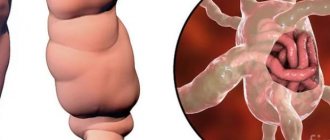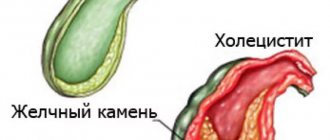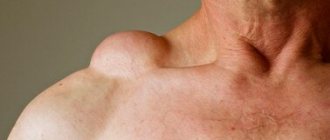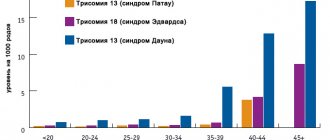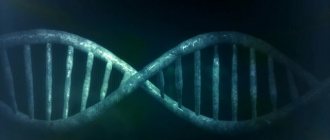CHAGAS DISEASE
(S. Chagas, Brazilian doctor, 1879-1934; synonym:
American trypanosomiasis, Chagas disease
) is a protozoan disease characterized by fever, swollen lymph nodes, often the development of a primary affect on the skin or conjunctiva, and sometimes severe damage to the heart and central nervous system.
There are acute and chronic stages of the disease.
In 1907, the Brazilian scientist Chagas discovered the trypanosome Trypanosoma cruzi in the intestines of flying bugs, and in 1909 he described a human disease in which he isolated a trypanosome (see), identical to the one he found in the bug.
The disease is widespread in most countries in South and Central America. According to the Pan American Health Organization (1974), in Latin American countries from 1969 to 1972, about 10 million patients with Chagas disease were registered.
Etiology
The causative agent of Chagas disease is Trypanosoma cruzi Chagas, 1909. The trypanosome is about 20 µm long and about 2 µm wide. mobile, equipped with a flagellum. In the body of humans and mammals, trypanosomes are carried by the blood and penetrate into the cells of internal organs and tissues, where they transform into the leishmanial form (round formations without a flagellum). In the affected cells, parasites multiply with the formation of the next form - amastigote. Then the amastigotes turn into t-shaped tripomasts, goths with a flagellum; they destroy the cell and re-enter the blood.
Chagas disease: examinations and diagnosis
Diagnosis of Chagas disease consists of three parts.
First, a medical history (history) , describing symptoms and indicating exposure to southern or Central American areas where Chagas disease is endemic.
The doctor may then detect a number of symptoms upon examination .
However, an accurate diagnosis can only be made on the basis of a blood test : detection of the pathogen in the blood. But since the virus is not always detected, a blood test is also performed to determine the presence of antibodies to trypanosomes. The necessary studies are carried out in special laboratories.
A blood test helps rule out other infectious diseases with similar symptoms, such as typhoid or malaria.
If Chagas disease is already in the chronic phase, the effects on the brain can be detected using computed tomography (CT) or magnetic resonance imaging (MRI). If the heart muscle is affected, this can be detected using an ultrasound of the heart (echocardiography).
Epidemiology
There are natural and synanthropic foci of the disease. In natural foci, sources of pathogens include armadillos, opossums, rodents, monkeys, etc.; in synanthropic foci - humans, as well as domestic animals (dogs, cats, pigs, etc.). The carriers of the pathogen are flying bugs (see Bugs), belonging to the species Bhodnius prolixus, Triatoma infestans, Panstrongylus meglstus, etc. Bugs are brightly colored, their length is 15-35 mm; They often live in living quarters, barns, and burrows of synanthropic rodents. Bedbugs attack humans and animals at night; They often bite people on the face, especially on the lips, which is why they are called kissing bugs. Bed bugs become infected by feeding on the blood of sick people or animals containing trypomastigotes. In the intestines of bedbugs, parasites multiply, transform into invasive trypanosomes and are excreted in feces after 15-30 days. Bedbugs retain trypanosomes throughout their lives - about 2 years. Trypanosomes released during blood sucking with bedbug feces enter the human or animal body through damaged skin (including at the site of a bedbug bite) and mucous membranes of the eyes. The endemicity of Chagas disease is determined by conditions conducive to the spread of bedbugs in populated areas.
How else can you get infected?
A person can become infected with Chagas disease if they consume food and water that has been in contact with someone who is infected. Trypanosome is also transmitted through blood transfusions and childbirth (when Chagas disease is diagnosed in the mother). Sometimes parasites can be contained in donor organs.
Free consultation on training issues
Our consultants are always ready to tell you about all the details!
There is the concept of laboratory contamination, when laboratory employees, while researching biomaterials, become infected with a disease pathogen. In the forests of southern countries there are animals such as raccoons and opossums. They are frequent carriers of trypanosomes, so any contact with them is potentially dangerous, especially if attacked or bitten by an animal. Pets are also no exception: sometimes you can get infected from a horse, cat or dog.
What increases the likelihood of infection?
Of course, if a person regularly lives in a poor rural area located in Mexico or South America, the risk of infection is very high. In addition, triatomine bugs can settle in any home if it is in their habitat.
Despite all the risks, Chagas disease practically does not occur among tourists, since when they come to southern latitudes, they live in good hotels. The most favorable environment for triatomine bugs to live and reproduce is clay, straw or hay. In order to avoid infection, tourists should not be tempted by the romantic prospect of spending the night in poor huts of the local population or dubious motels.
Pathogenesis and pathological anatomy
At the site of trypanosome penetration, a primary affect (shagoma) can develop - an inflammatory infiltrate, accompanied by lymphangitis and enlargement of regional lymph nodes. As a result of hematogenous dissemination, trypanosomes penetrate various organs and tissues: the heart, brain and spinal cord, liver, spleen, gastrointestinal tract, kidneys, adrenal glands, skeletal muscles, etc. Reproduction of parasites, their toxic-allergic effects, autoallergic reactions lead to inflammatory-dystrophic changes, hemorrhages. The most dramatic changes are found in the myocardium, liver, intestines, and brain. Diffuse myocarditis develops (see). Later, when the disease passes into the chronic stage, a kind of cardiomyopathy is observed (see), caused by damage to the conduction system of the heart.
An autopsy reveals a significant expansion of the cavities of the heart, thinning and bulging of the apical part of the left ventricle with the formation of an aneurysm (see Cardiac Aneurysm). There is an expansion of some parts of the digestive tract, most often the esophagus and colon, the cause of which is a violation of the autonomic innervation caused by damage to the intramural nerve plexuses.
Infection of the fetus through the placenta from a mother with Chagas disease is possible.
Classification
Chagas disease has several variants of its course:
- Acute American trypanosomiasis. If symptoms persist for less than 2 months. The parasite circulates in large quantities in the blood. It manifests itself most severely in children, while in adults it can be completely asymptomatic;
- Chronic American trypanosomiasis. Clinical manifestations may be absent for a long time, and the trigger for the deterioration of a person’s condition is severe damage to internal organs.
Clinical picture
The incubation period is 5-14 days. The acute stage of Chagas disease is observed mainly in children aged 1 to 5 years and adults traveling to areas endemic for Chagas disease. The disease begins with malaise, chills, headache, and muscle pain. The temperature rises to 39-40° and is remitting or constant. The primary affect, which often forms at the site of trypanosome penetration, resembles a boil in appearance, but never suppurates. When the parasite penetrates through the mucous membrane of the eye, the primary affect manifests itself in the form of the so-called Romagna symptom complex: conjunctivitis, swelling of the eyelids, with enlargement of regional lymph nodes. The liver, spleen and peripheral lymph nodes are enlarged. In the blood - leukocytosis with lymphomonocytosis.
Heart changes are one of the main manifestations of the acute stage of the disease. Its boundaries are expanded, the tones are muffled, and sometimes a gallop rhythm is heard (see Gallop rhythm). In severe cases, heart failure develops and worsens. The most severe manifestation of the acute stage of the disease is meningoencephalitis, almost always fatal. Lesions of other organs include orchitis (see), epididymitis (see) and mumps (see). The acute stage lasts 4-5 weeks, after which the clinical manifestations disappear and the process takes on a chronic course. This stage of Chagas disease can occur without clinical manifestations (latent) or is characterized by changes in the heart. Patients complain of shortness of breath, palpitations, pain in the heart area. The borders of the heart are expanded, the sounds are muffled, the pulse is small, blood pressure is reduced, splitting of the second tone is noted at the apex of the heart and on the pulmonary artery, systolic murmur at the apex of the heart and at the lower edge of the sternum, and extrasystole. Characterized by pronounced changes in the ECG in the form of intraventricular conduction disturbances. Particularly common is complete blockade of the right bundle branch (see Heart block). The course of the chronic stage of Chagas disease is long. Heart failure gradually progresses, usually leading to death. Cases of sudden death from acute heart failure, which may be caused by ventricular fibrillation, thromboembolism, or rupture of a cardiac aneurysm, have also been described. Frequent manifestations of Chagas disease in the chronic stage are changes in the digestive tract with expansion of its sections. This causes abdominal pain, difficulty swallowing, bloating, and constipation.
Diagnosis
in the acute stage of Chagas disease is diagnosed on the basis of epidemiological history, wedges, pictures and laboratory tests. Blood is usually tested for the presence of trypanosomes; if the result is negative - material from the primary affect, cerebrospinal fluid, punctures of lymph nodes, spleen and bone marrow. In the chronic stage, trypanosomes are rarely found in the blood and tissues. To confirm the diagnosis, a complement fixation reaction is used (see), and a bioassay is also carried out on white mice, injecting them with the patient’s blood, followed by testing for trypanosomes in the animal’s blood.
treatment
Treatment for Chagas disease focuses on killing the parasite and managing symptoms.
During the acute phase of Chagas disease, the prescription drugs benznidazole and nifurtimox may be helpful. Although benznidazole is approved by the Food and Drug Administration (FDA) for use in ages 2 to 12 years, it is not yet available in pharmacies in the United States. Nifurtimox is not currently approved by the FDA. Both drugs are available in regions most affected by Chagas disease. However, in the US, the drugs can only be obtained through the Centers for Disease Control and Prevention (CDC).
Once Chagas disease reaches the chronic phase, medications will not cure the disease. But, medications may be offered to people under 50 because they can help slow the progression of the disease and its most serious complications.
Additional treatment depends on specific signs and symptoms:
- Cardiac complications. Treatment may include medications, a pacemaker or other devices to regulate the heart rhythm, surgery, or even a heart transplant.
- Digestive complications. Treatment may include diet modification, medications, corticosteroids, or, in severe cases, surgery.
Prevention
Prevention consists of improving the sanitary and hygienic living conditions of the population and in the fight against blood-sucking flying clones - treating walls, ceilings of residential premises, and rodent burrows with insecticides; sealing cracks in the walls of premises. In areas endemic for Chagas disease, mandatory testing of blood donors using the complement fixation test is carried out; To protect against bedbug attacks, it is recommended to sleep under a canopy (see Protective nets).
See also Trypanosomiasis.
Bibliography:
Infectious diseases in the Americas in 1969-1972, WHO Chronicle, vol. 29, no. 8, p. 415, 1975; Kassirsky I. A. and Plotnikov N. N. Diseases of hot countries, p. 137, M., 1964; Kireev P. M. Diseases of internal organs in hot countries, p. 41, M., 1978; Kireev P. M. and Tyukov A. I. American trypanosomiasis, M., 1981; Expert Committee on Trypanosomiasis, trans. from English, Geneva, WHO, 1963; Loban K. M. and Plotnikov N. N. Lectures on infectious and parasitic diseases, part 1, p. 256, M., 1970; Tropical diseases, ed. E. P. Shuvalova, p. 347, M., 1979; With ha gas C. Nova tripanozomiaze humana, Mem. Inst. Osw., v. 1, p. 159, 1909.
P. M. Kireev.
Preparing for your appointment
You will most likely start by seeing your family doctor. Depending on his or her results, your doctor may refer you to an infectious disease specialist.
It is a good idea to be well prepared for your appointment. Here's some information to help you prepare for your appointment and what to expect from your doctor.
What can you do
- Write down any symptoms you experience, including any that may seem unrelated to the reason you made the appointment.
- Write down key personal information, including travel to other countries, major stressors, or recent life changes.
- Make a list of all the medications, vitamins, and supplements you take.
- Write down questions to ask your doctor.
Preparing a list of questions will help you make the most of your time with your doctor. For Chagas disease, some basic questions to ask your doctor include:
- What is the most likely cause of my symptoms?
- What tests do I need?
- Is my condition likely to be temporary or long-lasting?
- What treatments are available?
- I have these other health conditions. How can I best manage these conditions together?
- Am I contagious? Are other people who traveled with me likely to have become infected?
- Are there any brochures or other printed materials that I can take home with me? What sites do you recommend visiting?
What to expect from your doctor
Your doctor may ask you several questions, including:
- When did you first start experiencing symptoms?
- Were your symptoms constant or occasional?
- How severe are your symptoms?
- Does anything improve your symptoms?
- What if something seems to make your symptoms worse?
- Have you lived or traveled anywhere, such as Mexico, where triatomic error or Chagas disease is common?
Share link:
- Click to share on Twitter (Opens in new window)
- Click here to share content on Facebook. (Opens in a new window)
- Click to share on Telegram (Opens in new window)
Liked this:
Like
Similar
Possible complications
Even with therapy, Chagas disease often leads to the following complications:
- heart failure;
- meningoencephalitis;
- diffuse myocarditis;
- cardiomegaly;
- heart attack;
- stroke;
- hemorrhage in the meninges.
Consequences of the development of the disease during pregnancy:
- spontaneous abortion;
- premature labor;
- intrauterine infection of the fetus.
In newborns and older children, Chagas disease is complicated by the following conditions:
- severe anemia;
- intestinal obstruction;
- jaundice;
- convulsive seizures.



